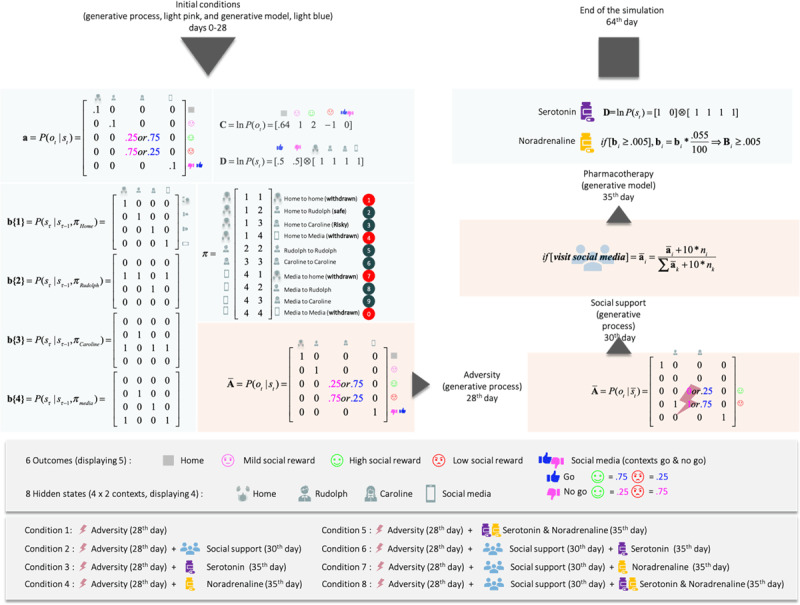Figure 3.

This figure details the likelihood and prior transition probabilities for our generative model of prosocial exchanges. The variables pertaining to the generative model are shown in light blue boxes, while the corresponding parameters of the generative process (i.e., the social world) are shown in light pink. The states and outcomes in this model are generated under two contexts pertaining to Caroline’s availability: available or not available. For ease of visualization, we have shown context-sensitive outcome likelihoods. In other words, there are six potential outcomes, but we have conditioned the epistemic (‘go’ and ‘no-go’) outcome on the context (to generate five outcomes). This simplifies the graphics and is licensed by the fact that only the epistemic outcome is context-sensitive. The top-left section corresponds to the contingencies during the initial exchanges (days 0–28) and corresponds with the narrative description in Figure 1. The adverse life event on the 28th day amounts to Rudolph and Caroline (on a good day) now yielding negative outcomes, and Caroline, even on a good day, affording negative outcomes. Adversity happens when the agent is sensitive to (i.e., prone to learn) the social environment. We implemented this by reinitialising the counts over the sensory prior beliefs of the agent (a). Social adversity and support are modelled by changing the precision or reliability of social outcomes in the generative process – in response to social signals. This is a subtle aspect of this model; namely, the generative process or social environment responds adaptively to the agent’s behaviour. As of the 30th day (for the conditions involving social support), we implement social support by adding counts (+10) to the likelihood of the environment counts (+10) for the cells corresponding to the mappings ‘Rudolph and positive outcomes’, ‘Caroline good day context and positive outcome’, and ‘Caroline busy day context and negative outcome’. The n_i corresponds to the number of times the agent visited the location a_i. The increase in counts has the ultimate consequence of driving the probability mapping in the (A) of the generative process towards and beyond their initial values more. A ‘+10’ is added to the cells every time the agent solicits the epistemic cue (i.e., social media). This implements the social signalling characteristic of adaptive low mood. Pharmacological interventions on the 35th day include the following: Serotonin provides an optimistic bias by changing prior beliefs about the initial states, in favour of the ‘Go’ context (from .5;.5 to .99;.01). Noradrenaline decreases the precision of the transition probability matrices B (i.e., it increases uncertainty about future states), which leads to a gradual accumulation of uncertainty about unvisited states. Through the expected ambiguity component of expected free energy G, it tends to motivate exploratory behaviours. The agent continues to learn the state transition after we administer noradrenaline.
